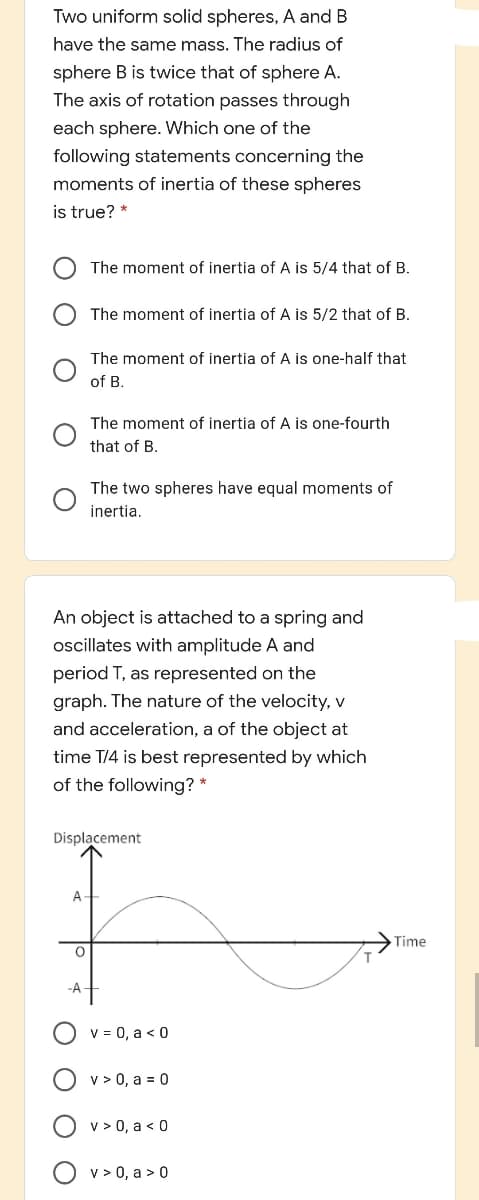Two uniform solid spheres, A and B have the same mass. The radius of sphere B is twice that of sphere A. The axis of rotation passes through each sphere. Which one of the following statements concerning the moments of inertia of these spheres is true? *
Two uniform solid spheres, A and B have the same mass. The radius of sphere B is twice that of sphere A. The axis of rotation passes through each sphere. Which one of the following statements concerning the moments of inertia of these spheres is true? *
University Physics Volume 1
18th Edition
ISBN:9781938168277
Author:William Moebs, Samuel J. Ling, Jeff Sanny
Publisher:William Moebs, Samuel J. Ling, Jeff Sanny
Chapter10: Fixed-axis Rotation
Section: Chapter Questions
Problem 10.5CYU: Check Your Understanding What is the moment of inertia of a cylinder of radius R and mass m about an...
Related questions
Question
need the solves asap... only choose right ans

Transcribed Image Text:Two uniform solid spheres, A and B
have the same mass. The radius of
sphere B is twice that of sphere A.
The axis of rotation passes through
each sphere. Which one of the
following statements concerning the
moments of inertia of these spheres
is true? *
The moment of inertia of A is 5/4 that of B.
The moment of inertia of A is 5/2 that of B.
The moment of inertia of A is one-half that
of B.
The moment of inertia of A is one-fourth
that of B.
The two spheres have equal moments of
inertia.
An object is attached to a spring and
oscillates with amplitude A and
period T, as represented on the
graph. The nature of the velocity, v
and acceleration, a of the object at
time T/4 is best represented by which
of the following? *
Displacement
A
Time
-A
v = 0, a < 0
v > 0, a = 0
v > 0, a < 0
v > 0, a > 0
Expert Solution
This question has been solved!
Explore an expertly crafted, step-by-step solution for a thorough understanding of key concepts.
This is a popular solution!
Trending now
This is a popular solution!
Step by step
Solved in 3 steps

Recommended textbooks for you

University Physics Volume 1
Physics
ISBN:
9781938168277
Author:
William Moebs, Samuel J. Ling, Jeff Sanny
Publisher:
OpenStax - Rice University

Principles of Physics: A Calculus-Based Text
Physics
ISBN:
9781133104261
Author:
Raymond A. Serway, John W. Jewett
Publisher:
Cengage Learning

College Physics
Physics
ISBN:
9781938168000
Author:
Paul Peter Urone, Roger Hinrichs
Publisher:
OpenStax College

University Physics Volume 1
Physics
ISBN:
9781938168277
Author:
William Moebs, Samuel J. Ling, Jeff Sanny
Publisher:
OpenStax - Rice University

Principles of Physics: A Calculus-Based Text
Physics
ISBN:
9781133104261
Author:
Raymond A. Serway, John W. Jewett
Publisher:
Cengage Learning

College Physics
Physics
ISBN:
9781938168000
Author:
Paul Peter Urone, Roger Hinrichs
Publisher:
OpenStax College

Physics for Scientists and Engineers: Foundations…
Physics
ISBN:
9781133939146
Author:
Katz, Debora M.
Publisher:
Cengage Learning

Classical Dynamics of Particles and Systems
Physics
ISBN:
9780534408961
Author:
Stephen T. Thornton, Jerry B. Marion
Publisher:
Cengage Learning

Glencoe Physics: Principles and Problems, Student…
Physics
ISBN:
9780078807213
Author:
Paul W. Zitzewitz
Publisher:
Glencoe/McGraw-Hill